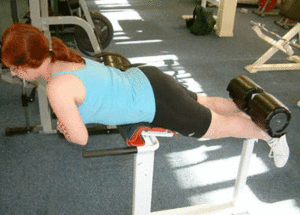Biering-Sorenson Test
Original Editor - Uchechukwu Chukwuemeka Top Contributors - Uchechukwu Chukwuemeka, Wanda van Niekerk, Lucinda hampton and Kim Jackson
Purpose[edit | edit source]
The Biering-Sorenson test was first described by Hansen in 1964 as an examination of the isometric endurance of the hip and back extensor muscles. Following a study by Beiring-Sorenson, it was found to be a good assessment tool for predicting the risk of non-specific lower back pain in patients/clients.
The test as described by Sorenson[1] is "measuring how many seconds the subject is able to keep the unsupported upper body (from the upper border of the iliac crest) horizontal, while placed prone with the buttocks and legs fixed to the couch by three wide canvas straps and the arms folded across the chest.”
- The Sorensen test has been validated as a differential diagnostic test for low back pain. Those with low back pain have significantly lower hold times than those without low back pain.
- In subjects with low back pain, the mean endurance time ranges from 39.55 to 54.5 seconds in mixed-gender groups (compared with 80 to 194 seconds for men and 146 to 227 seconds for women without pain)[2].
Technique[edit | edit source]
To begin this test, an examination plinth, a stopwatch and three to four straps are needed.
- The starting position is the patient/client adopting a half prone lying on a plinth with the superior edge of the iliac crest at the edge of the plinth and the arms crossed over the chest.
- The lower limbs are strategically stabilized with straps. The patient/client is asked to maintains the upper body in a horizontal position and the timer is started.
- The test ends if the patient/client can maintain the said position for 4 minutes (240 seconds) or can no longer maintain the set position before 4 minutes elapses. The stop time is recorded.[3]
This 7 and a bit minute video outlines the test and other related facts.
Evaluating[edit | edit source]
The Sorensen test has been validated as a differential diagnostic test for low back pain. Individuals with low back pain have significantly lower hold times than those without low back pain. In subjects with low back pain, the mean endurance time ranges from 39.55 to 54.5 seconds in mixed-gender groups (compared with 80 to 194 seconds for men and 146 to 227 seconds for women without pain).
- Mean endurance time for all subjects (with and without low back pain) in one study was 113 ± 46 seconds. Men had higher mean endurance than women.
- Because average endurance times have not been established for older individuals, caution should be exercised when testing individuals aged 60 years and older. Decrease in endurance time should be expected with increasing age[2]
AGE-BASED NORMS FOR SORENSEN TEST
| Age | Mean Hold Time in Seconds (SD)*Males | Mean Hold Time in Seconds (SD)Females |
| 19-29 | 1405 | 1305 |
| 30-39 | 1405 | 120 |
| 35-39 | 97 (43)2 | 93 (55)2 |
| 40-44 | 101 (57)2 | 80 (55)2 |
| 40-49 | 1105 | 905 |
| 45-49 | 99 (58)2 | 102 (64)2 |
| 50-54 | 89 (55)2 | 69 (60)2 |
| 50-59 | 905 | 805 |
| 60+ | 805 | 905 |
Validity[edit | edit source]
A study by Adams et al.[5] in 1999 reported a predictive validity of R= -0.01 and found a relationship between fatigability and back muscle strength. The study also reported a significant association between Biering-Sorensen endurance time and self report of LBP history at baseline in adolescents (p= .006). Demoulin et al.[6] shows that maintaining the Biering–Sorenson position for less than 176 seconds, predicts low back pain within the next year and greater than 198 seconds predicts absence of low back pain. It also reported that Biering-Sorenson test does not have a ceiling effect.
Simmonds et al. (1998)[7] supports the discriminant properties of the test; it found a statistically significant difference between the performance of LBP patients and healthy participants and controls. This report was also supported by the research done by Keller et al.[8] in 2001.
Ghroubi et al. (2015)[9] reported a good divergent validity as VAS pain has a poor relationship with functional impairment indices (p > 0.05) and excellent convergent validity as Biering-Sorenson test shows a statistically significant relationship with the Borg scale (r = 0,4, p = 0,02), and the Shirado test (r = 0,59, p < 0,001).
References[edit | edit source]
- ↑ Biering–Sorensen F. Physical measurements as risk indicators for low-back trouble over a one-year period. Spine. 1984;9:106–119.
- ↑ 2.0 2.1 Musculoskeletal Key Testing the Muscles of the Trunk and Pelvic Floor Available:https://musculoskeletalkey.com/testing-the-muscles-of-the-trunk-and-pelvic-floor/(accessed 30.1.2022)
- ↑ Beiring-Sorenson test. 2015. Available from:https://www.sralab.org/rehabilitation-measures/beiring-sorensen-test (assessed 11 January 2020)
- ↑ Kayla Saraiva. Biering Sorensen. Available from: http://www.youtube.com/watch?v=pLnSRlop4vk [last accessed 8/1/2020]
- ↑ Adams M, Mannion A. Dolan P. Personal Risk Factors for First-Time Low Back Pain. Spine. 1999;24(23):2497-2505.
- ↑ Demoulin C, Vanderthommen M, Duysens C, Crielaard CM. Spinal muscle evaluation using the sorensen test: a critical appraisal of the literature. Joint Bone Spine. 2006;73(1): 43-50.
- ↑ Simmonds MJ, Olson SL, Jones S, Hussein T, Lee CE, Novy D, et al. Psychometric characteristics and clinical usefulness of physical performance tests in patients with low back pain. Spine. 1998; 23(22):2412-2421.
- ↑ Keller A, Hellesnes J, Brox JI. Reliability of the isokinetic trunk extensor test, Biering-Sørensen test, and Åstrand bicycle test: Assessment of intraclass correlation coefficient and critical difference in patients with chronic low back pain and healthy individuals. Spine. 2001;26(7): 771-777.
- ↑ Ghroubi S, Jribi S, Jdidi J, Yahia A, Elleuch W, Chaaben M, et al. Study of the validity and reproducibility of the Biering-Sorensen test in chronic low back pain Annals of Physical and Rehabilitation Medicine. 2015; 58(1):e88








